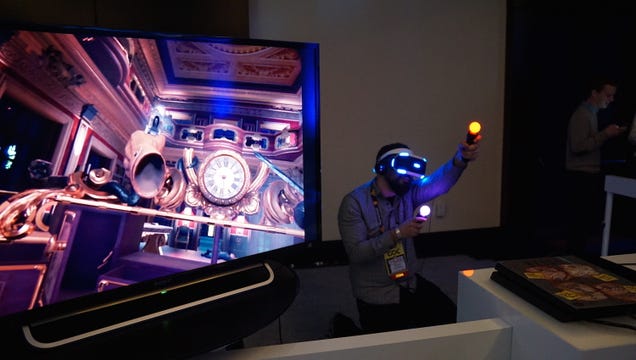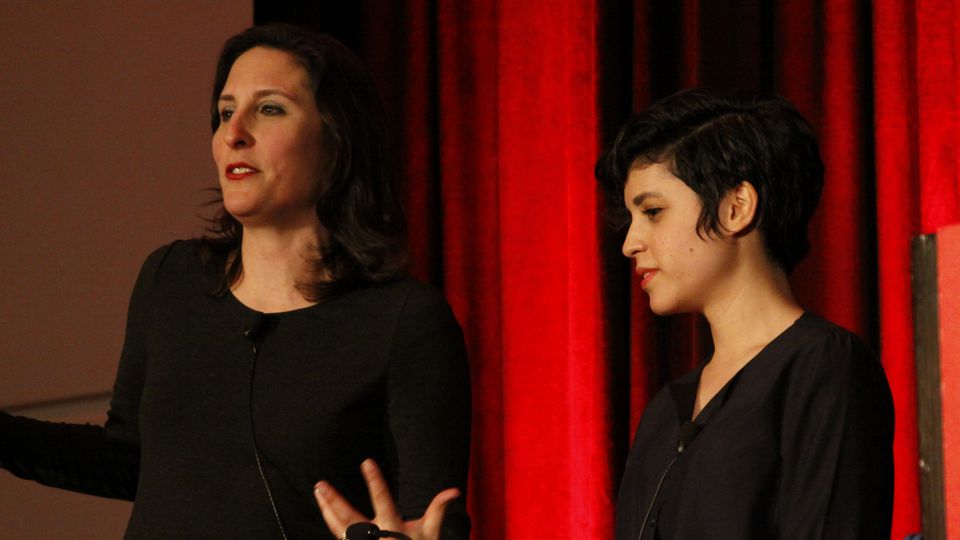
The Game Developers Conference (GDC) is the world’s largest and longest-running professionals-only game industry event. GDC see mores than 24,000 attendees and is a great place for industry leaders —from programmers and designers to business people — to shape the future of gaming. The conference features many panels, lectures, and “round-table” discussions that cover a wide range of industry topics. Tons of neat things come out of GDC, and this year is no exception. Read more for all the cool things!
 One of the biggest things to come out of GDC this year is all the new VR tech. Oculus’ newest version, Crescent Bay, made people sweat with a demo starring Smaug, the great and terrible. Though it requires no participation from the user, suddenly you know what Bilbo felt like as Smaug senses your presence and starts to search for you.
One of the biggest things to come out of GDC this year is all the new VR tech. Oculus’ newest version, Crescent Bay, made people sweat with a demo starring Smaug, the great and terrible. Though it requires no participation from the user, suddenly you know what Bilbo felt like as Smaug senses your presence and starts to search for you.
Oculus isn’t the only contender, though. Many people are saying Valve’s new VR, Vive, is going to “win” over the competition. Noting that when he’s used the other kits before, he felt “some sense of relief upon taking the headset off,” Graham Smith of Rock, Paper, Shotgun said, “When my twenty minutes with Valve and HTC’s Vive came to an end, I felt no relief. Instead, I only felt disappointed that I couldn’t continue exploring ...” Valve even had all of their previous VR experiments on display.
 But we can’t forget about Sony’s Project Morpheus, either. Interestingly, Sony demo’d an FPS called London Heist for its virtual reality headset. Kotaku writer Stephen Totilo wrote about his experience with the demo, and he seems to be pretty excited about it.
But we can’t forget about Sony’s Project Morpheus, either. Interestingly, Sony demo’d an FPS called London Heist for its virtual reality headset. Kotaku writer Stephen Totilo wrote about his experience with the demo, and he seems to be pretty excited about it.
Some other big topics making headlines recently, have been how the gaming industry treats certain social issues. The number of panels at GDC regarding those exact things speak to how import it is to talk about these issues, such as racial and gender representation/equality.
 Professor/ game designer Derek Manns and Dennis Mathews had a roundtable discussion on black stereotypes in gaming, talking about black characters and the developers that make them. After a while, the discussion was opened to the audience, where participants asked profound questions and shared inspiring anecdotes.
Professor/ game designer Derek Manns and Dennis Mathews had a roundtable discussion on black stereotypes in gaming, talking about black characters and the developers that make them. After a while, the discussion was opened to the audience, where participants asked profound questions and shared inspiring anecdotes.
An all-female panel moderated by Lil Chen titled, “Growing the Participation of Women in eSports,” dove into how hard it is for women to get into eSports, and how it’s like “walking through a minefield.” They touched on many issues, but most of them had one thing in common: they distracted from the actual ability of a woman in eSports. Instead, most of the focus goes into a female players look or personality. They considered solutions, but most notably of which is to write more positive press about female players, “since much of the press coverage tends to focus on controversies when it comes to female eSports figures.”
Todd Harper, a visiting professor at the University of Baltimore, discussed how the token fat stereotype in games is wrong, and urged developers to stop defaulting to that. Characters like Wario generally have an obsession with eating and are objectively considered “ugly,” whereas characters like Ellie from Borderlands 2 are not defined or even inhibited by their weight, and have several other unrelated qualities. “Don’t reinforce negative stereotypes.” Harper said. “Thinness is not the enemy, but cultures that punish people for not being an ‘ideal’ shape are.”
 Ashly Burch and Rosalind Wiseman presented the results they gathered from a study they conducted. The study shows how “today’s young consumers are far more progressive than the games industry gives them credit for.” They asked middle/ high school boys and girls different questions regarding video games. Only 39% of high-school aged boys that were surveyed preferred to play as male characters, while 60% of HS girls preferred to play as female characters.
Ashly Burch and Rosalind Wiseman presented the results they gathered from a study they conducted. The study shows how “today’s young consumers are far more progressive than the games industry gives them credit for.” They asked middle/ high school boys and girls different questions regarding video games. Only 39% of high-school aged boys that were surveyed preferred to play as male characters, while 60% of HS girls preferred to play as female characters.  This 21% gap, they said, is enough of a reason for developers to reevaluate their future protagonists. Burch explained, “it could be that we are falsely attributing the success of past games to things that don’t actually matter to the kids that are playing them.” I would recommend reading more of their findings and looking at their actual slides.
This 21% gap, they said, is enough of a reason for developers to reevaluate their future protagonists. Burch explained, “it could be that we are falsely attributing the success of past games to things that don’t actually matter to the kids that are playing them.” I would recommend reading more of their findings and looking at their actual slides.
The #1ReasonToBe panel was probably the most emotional panel at GDC this year. In it’s third year at GDC, the group focused on the women in the panel and their reasons to be a game developer. In the powerful “empty chair” segment, they shared the written words of women who have been silenced, whether it be out of fear or even company policy.
[youtube http://www.youtube.com/watch?v=J7HuC_aLkoE&w=560&h=315]
Game critic Katherine Cross ended the #1ReasonToBe panel with an impassioned speech about never giving up, even when it’s tough. “I wanted to do anything I could to make the pain stop,” she said, “so I made a choice: write more about games than ever. ” The room stood up in applause.
Not everything was so serious, however. Bungie talked about Destiny’s infamous “loot cave,” and why they actually patched it out. They knew about the loot cave pre-launch. “Shooting at a black hole for hours on end isn’t our dream for how Destiny is played,” user research John Hopson said. One of the reasons it was patched, was because the cave wasn’t as good as players thought. “They were very weak enemies that didn’t drop very good loot.” They divulged that the biggest reason, however, was because of how many players were reported for cheating.
In addition to panels and announcements, GDC also hosts an indie games festival. Here’s a list of all the Indie games to come out of GDC.
 Last but not least, there’s the Game Developers Choice Awards. Hosted by Tim Schafer, the show celebrates the creativity and “technical genius” of the last year’s games. This year, Schafer took an opportunity to joke a little bit about GamerGate, unsurprisingly causing quite the hullabaloo on twitter. Wondering who took the overall best game of 2014? Well, that would be Shadow Of Mordor. If you’re curious to see the other winners and nominees, check out the site.
Last but not least, there’s the Game Developers Choice Awards. Hosted by Tim Schafer, the show celebrates the creativity and “technical genius” of the last year’s games. This year, Schafer took an opportunity to joke a little bit about GamerGate, unsurprisingly causing quite the hullabaloo on twitter. Wondering who took the overall best game of 2014? Well, that would be Shadow Of Mordor. If you’re curious to see the other winners and nominees, check out the site.
2 comments